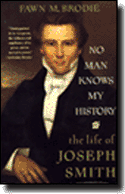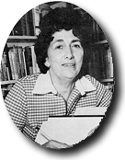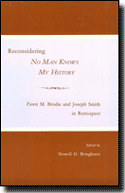
![]()

![]()
1. p. Alfred A. Knopf, Inc. 1945, 2. uudistettu laitos 1971
Oma kappaleeni on First Vintage Books Edition, August 1995,
ISBN 0-679-73054-0
 Tämä
on ehkä tunnetuin kaikista Joseph Smith-elämäkerroista. Kirja kuuluu niihin
perusteoksiin, jotka jokaisen mormonismista kiinnostuneen pitäisi lukea,
varsinkin niiden, jotka aikovat liittyä kirkkoon.
Tämä
on ehkä tunnetuin kaikista Joseph Smith-elämäkerroista. Kirja kuuluu niihin
perusteoksiin, jotka jokaisen mormonismista kiinnostuneen pitäisi lukea,
varsinkin niiden, jotka aikovat liittyä kirkkoon.
rpcman kirjoittaa:
Kun sain kirjan loppuun, ajattelin että jos vain 10 prosenttiakin siitä oli totta, niin mormonikirkko ei todellakaan ole sitä mitä se väittää olevansa. Luettuani [historioitsija] Hugh Nibleyn vastineen, tajusin, että paljon enemmän kuin 10% siitä oli totta.
Kirja ei ole läheskään täydellinen, mutta älä luota jonkun mormonin sanaan siitä, kun hän väittää, että "[Brodie] jättää tietoa ja lähteitä, jotka eivät tue hänen ennakolta muodostettuja mielikuviaan". Vaikka tämä väite saattaa osittain pitää paikkansa, tosiasiassa Joseph Smithiä objektiivisesti tutkivien päätelmät ovat hyvin erilaisia kuin ns. tosiuskovaisten mormonien, joiden on tapana "jättää huomiotta tietoa ja lähteitä, jotka eivät tue heidän ennakolta muodostettuja mielikuviaan".
 |
|
Fawn McKay Brodie
1915-1981 |
Muiden muassa Hugh Nibley, mormoniuskon arkkipuolustaja, on kritisoinut teosta artikkelissaan Ei rouva, ei tuo ole historiaa. Lisäkommentteja löytyy artikkelista Reconsidering No Man Knows My History: Fawn M. Brodie and Joseph Smith in Retrospect.
FARMS (Louis Midgley) on myös arvostellut Brodien teosta osittain siten, että heidän mielestään Brodie on etukäteen päättänyt epäillä Joseph Smithin aitoutta — ironista kyllä he unohtavat samalla että he itse epäilevät rutiininomaisesti kirjoittajia, joiden teksti ei sovellu heidän uskontoonsa.
Brodie on myös kirjoittanut Richard Nixonin ja Thomas Jeffersonin elämäkerrat. Jeffersoninhan on myöhemmin todettu pitäneen yhtä neekerorjattaristaan, Sallya, rakastajattarenaan, ja saaneen hänen kanssaan lapsia, niin kuin Brodie kirjoittikin aikoinaan (1974). DNA-tutkimukset ovat todenneet Brodien olleen oikeassa.
Mormonit ovat aina pilkanneet Brodieta, mutta hyvin harvat ovat edes vaivautuneet lukemaan hänen teoksensa. Heidän arvostelunsa ja pilkkansa ovat kotoisin m.m. Nibleyltä ja siitä, että he eivät tietenkään pysty uskomaan mitään negatiivista profeetastaan, ja kun he ovat kuulleet Brodien kirjoittavan Smithistä negatiivisesti, niin he eivät koske kirjaan. Nibley ja muut arvostelijat vaativat Brodielta suurempaa täydellisyyttä kuin itseltään tai omilta profeetoiltaan, mitä on vaikea hyväksyä. Itse asiassa Brodie yrittää ymmärtää Smithiä melko pitkälle. Brodie on turhaan joutunut hyvin huonoon maineeseen mormonipiireissä, osaksi koska hänet erotettiin kirkostakin lähinnä kirjansa vuoksi. Sellainen ei tee tälle kirjailijalle oikeutta. Mutta jos on tosiuskovainen mormoni, mikään muu kuin Smithin ihaileva korokkeelle nosto ei kelpaa. Tämä on tavallista lahkoajattelua — mikä tahansa omaa uskoa arvosteleva kritiikki on ilman muuta valheellista, vääristeltyä ja/tai saatanasta kotoisin. Tässä suhteessa mormonikirkko on samanlainen kuin mikä tahansa lahko tai kultti, joiksi he eivät tietenkään itseään miellä.
Brodie valmisti kirjan ensimmäisen laitoksen ja julkaisi sen 1945, joten voi helposti kuvitella, ettei hänellä ollut kaikkea mahdollista materiaalia ulottuvillaan. Toiseen painokseen tuli paljon parannuksia (julk. 1971). Sanottakoon Brodien spekuloinneista mitä tahansa, hän on joka tapauksessa koonnut yksien kansien sisään paljon tietoa, joka olisi hyödyllistä jokaisen mormonin tietää. Ikävä kyllä he uskovat kirjan poistavan Joseph Smithin pään päältä sen pyhimyksen sädekehän, jonka he mielellään näkevät sielunsa silmillä ja haluavat sen siellä pitää, huolimatta tosiasioista, joilta he mieluummin sulkevat silmänsä.
En tiedä kenenkään koskaan väittäneen, että tämä elämäkerta olisi virheetön. Lue toki paljon muutakin mormonismia koskevaa kirjallisuutta. Lue kaikenlaisia teoksia, sekä puolesta että vastaan, ja muodosta sitten oma mielipiteesi ja kantasi. Jos silti tuntuu vaikealta ottaa käteensä joku tällainen "anti-mormonistinen" kirja, niin lempeämpi vaihtoehto on Donna Hillin uudempi (ja laimeampi) elämäkertateos Joseph Smith: The First Mormon.
Sisältö
- The Gods Are among the People
- Treasures in the Earth
- Red Sons of Israel
- A Marvelous Work and a Wonder
- Witnesses for God
- The Prophet of Palmyra
- The Perfect Society and the Promised Land
- Temple-Builder
- Expulsion from Eden
- The Army of the Lord
- Patronage and Punishment
- Master of Languages
- My Kingdom is of this World
- Disaster in Kirtland
- The Valley of God
- The Alcoran or the Sword
- Ordeal in Liberty Jail
- Nauvoo
- Mysteries of the Kingdom
- In the Quiver of the Almighty
- If a Man Entice a Maid
- The Bennett Explosion
- Into Hiding
- The Wives of the Prophet
- Candidate for President
- Prelude to Destruction
- Carthage
Epilogue
Supplement
Appendix A Documents on the Early Life of Joseph Smith
Appendix B The Spaulding-Rigdon Theory
Appendix C The Plural Wives of Joseph Smith
Teosta tarkastellaan kirjassa
 Reconsidering
No Man Knows My History : Fawn M. Brodie and Joseph Smith in Retrospect
Reconsidering
No Man Knows My History : Fawn M. Brodie and Joseph Smith in Retrospect
jonka on toimittanut Newell G. Bringhurst
Sisältö
Foreword: The Example of Fawn McKay Brodie, A Tribute vii William Mulder
Acknowledgements xiii
Introduction 1 Newell G. Bringhurst
- A Biography of the Biography: The Research and Writing of No ManKnows My History - Newell G. Bringhurst
- Applause, Attack, and Ambivalence: Varied Responses to No Man Knows My History - Newell G. Bringhurst
- Secular or Sectarian History? A Critique of No Man Knows My History - Marvin S. Hill
- Fawn McKay Brodie: At the Intersection of Secularism and Personal Alienation - Mario S. De Pillis
- Literary Style in No Man Knows My History: An Analysis - Lavina Fielding Anderson
- Fawn Brodie on Joseph Smith's Plural Wives and Polygamy: A Critical View - Todd Compton
- From Old to New Mormon History: Fawn Brodie and the Legacy of Scholarly Analysis of Mormonism - Roger D. Launius
Notes on the Contributors
Index
Ote luvusta 1
Fawn Brodie did not originally set out to write a biography of Joseph Smith per se. Instead, she explained years later that when a study of the anthropology of American Indians convinced her that tehy were of Mongoloid rather than Hebraic origin, she wanted to satisfy herself by exploring "how the Book of Mormon came to be written." Also prompting her were questions posed by her husband Bernard, "totally new to the Mormon scene and very fascinated by it." But as Brodie got inteo her reasearch, she found there was "no good biography of Joseph Smith" and thus undertook the task herself. A third factor, according to Brodie, was that "the whole problem of [Smith's] credibility ... was crying out for some explanation." Brodie characgerized her effort as compelling detective work: "It was fantastic! I was gripped by it."
Finally, and perhaps most important, a compelling set of personal concerns motivated Brodie. The author candidly confessed that her study of Smith did for her "what an autobiographical novel usually does for the young novelist" in that "there was a compulsion to self-expression...as well as a compulsion to liberate [herself] wholly from Mormonism, and perhaps also certain family relationships." In other words, as Brodie's good friend and mentor, Dale L. Morgan noted this work served as "a kind of a catharsis." Or as Brodie herself told her favorite uncle, Dean Brimhall, some years later, her work on Joseph Smith represented a desperate effort to come to terms with her childhood.
Brodie began her research in 1938, while working in the University of chicago library, following the completion of her master's degree in English. Her position at chicago's Harper Library gave her access to various books and historical materials. She later recalled, , "Eery book I asked for was there, including crucial books by Ethan Smith an dElias Boudinor and others, who believed that the American INdians had been descended from the Lost Tribes of Israel." Harper Libarry's great collection on the history of upstate and western New York enabled Brodie to learn about hte mound builder Indians and about the "Anti-masonic excitement" that swept the area in 1827, when the Book of Mormon was being written. Also available were the sermons of the evangelist preachers of the 1820s in the Palmyra area. Throught these materials, Brodie learned about "millennialism and the health food passions that would later psark such religoius leaders as William Miller, founder of the Seventh Day Adventist church, and Mary Baker Eddy, founder of Christian Science."
In June 1939, Brodie shared her findings with Dean R. Brimhall. "Most of my spare time this past year," she told Brimhall, "I have spent analyzing the Book of Mormon & United Order. ... I have had the most fun with the Book of Mormon & was able to trace almost every idea in it right down to Ontario Co. New York 1827 [including] the lost tribe theory, the exterminated race theory, anti-Masonry, anti-Catholicism--the whole gamut of sectarian religious controversy."
Brodie then revealed to Brimhall her ultimate goal: "I hope sometime to be able to turn out a genuinely scholarly biography. ... I've geen atnint to tell someone besides [husband] Bernard what I'm doing," explaining, "I can't, of course, confide in my family." She then asked her uncle: "I hope sometime that you'll have the time to look over some of the reaserach I've been doing on Joseph Smith. I think you rown analysis is sane & judicious, perhaps because it conforms with my own."
In the fall of 1939, Fawn Brodie overcame her initial reluctance concerning immediate family, sharing the results of her research with her younger brother, Thomas B. McKay. After returning from a Mormon mission to Germany, he enrolled as an undergraduate student at the University of Chicago. He lived near his sister Fawn, which enabled hi m to interact with her as she pushed ahead with her research.
Thomas was bright an dinquisitive, taking an interest in what Fawn was doing. In fact, he looked at many of the very same materials on Joseph Smith and Mormon origins. This generated great discussions on much of the material that went into the biography, with Fawn and Thomas differing sharply in theri views. Thomas recalled, "I would look at it from the aspect of one who is thoroughly convinced that Joseph Smith was a prophet" whereas Fawn looked at the same information from the perspective of one thoroughly "convinced that he was not a prophet.2
Fawn Brodie was particularly bothered by disclosures of Sith's early activities as a money-digger, telling her brother that the Lord would never have permitted Smith to take part in such activity "if he was going to be the Lord's prophet." Whereas Thomas asserted thta Mormonism's founder "was a very poor youth" engaging in money-digging as a means to generate revenue for his financially impoverished family, noting that at that early date, Smith had not yeat "proclaimed himself the prophet." Money-digging, he added, "was a very respected profession" at that time. Such arguments notwithstanding Thomas recalled: "Neither did [Fawn] change my mind nor did I change hers."
More significant was the input that Fawn received from her husband throughout the course of her research and writing. Bernard acted as a "sounding board" for the author's ideas and evaluated her written presentation. Fawn praised her husband as "immensely helpful" in acting as a most valuable critic in evaluating her research with a detachment she could never have and she called him "a first rate literary critic besides." Bernard, moreover, exerted a moderating influnece on the author relative to her overall evaluation of Joseph Smith. Brodie confessed that her work would have been a harsher indictment of Joseph Smith had it not been for Bernard's influence: "I was angered by the obvious nature of the fraud in his writing of the Book of Mormon... [but Bernard] kept urging me to look at the man's genius, to explain his successes, and to make sure that the reader understood why so many people loved him and believed him. If there is real compassion for Joseph Smith in the book," Brodie confessed, "and I believe there is, it is more the result of the influence of my husband than anyone else."
The help and encouragement of Bernard notwithstanding, Fawn Brodie's main concern was not Joseph Smith during the three years from mid-1939 to late 1942. The Brodies focused first and foremost on completion of Bernard's own graduate studies at the University of Chicago. He received his doctorate in international relations in 1940. And then the Brodies moved two times, first to Princeton, New Jersey, in 1940; and then, a year later, to Hanover, New Hampshire, and Dartmouth College as Bernard sought a suitable academic position. In addition, by late 1942, Fawn devoted much of her time and energy to the care of her first child, Richard McKay Brodie, born November 7, 1942. Also during this period, she concentrated her major literary efforts outside of Mormon history. Influenced by the prevailing environment of patriotism and service generated by World War II, Brodie felt ocmpelled to contribute her literary talents. Accordingly she collected material for and wrote the introductions for two wartime pamphlets. The first, Our Far Eastern Record, was published in early 1942, and the second, which appeared later that same year, was entitled Peace Aims and Post-War Planning: A Bibliography.
In a June 1942 letter to her uncle Dean Brimhall, Brodie wrote that work on these two pamphlets had forced her to "neglect" the Mormon leader for "several months," confessing "neither job has been in the least creative, but they somehow seemed more pertinent to 1942 than hunting up data on what happened in Nauvoo in 1842. ... Of course I never really lose interest in church history."...
Etusivu > Kirjallisuus | Sivun alkuun